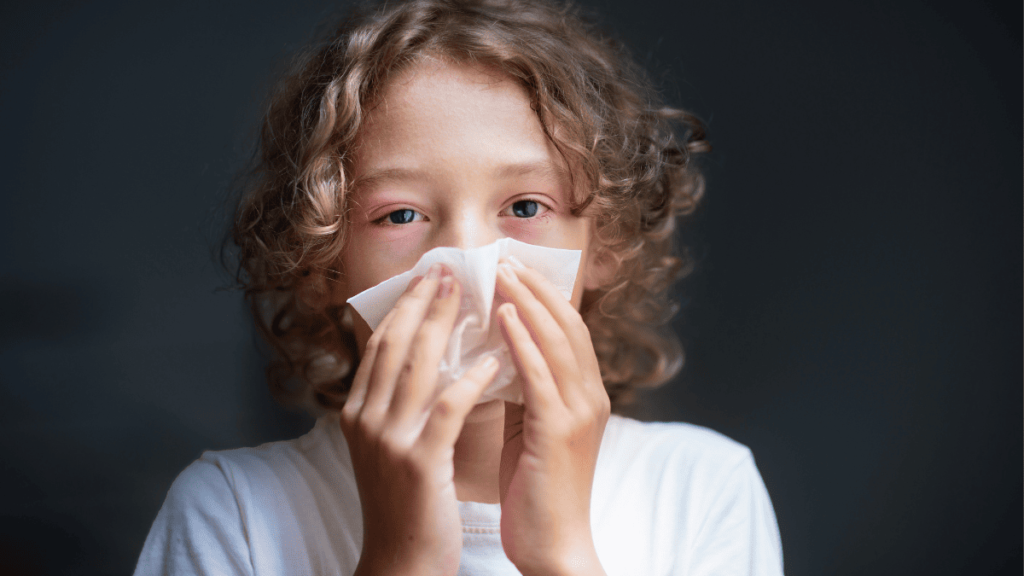A staggering 10% of respiratory infections in children are caused by the HMPV or Human Metapneumovirus . It’s crucial to know its symptoms and causes. It is similar to Covid-19 and many cases found in China

This knowledge helps in managing and preventing infections. The HMPV is a common cause of respiratory illness. Knowing its symptoms is key for effective prevention and treatment.
It’s vital to understand the HMPV and its symptoms. This is to protect vulnerable people, like the elderly and young children. They are at a higher risk of severe complications.
By recognizing the symptoms of Human Metapneumovirus, people can take steps to prevent its spread.
Understanding the Human Metapneumovirus
The HMPV, also known as Human Metapneumovirus, is a major respiratory pathogen. It’s important to know its definition and history. The virus was first found in 2001, and studies have shown its effects on health.
Key points about the HMPV include its discovery, spread, and challenges it brings. Knowing these helps in fighting the virus. The virus’s history shows it can cause serious respiratory illnesses, mainly in vulnerable groups.
Read More Blog about Sign Symptoms of Cervical Cancer
What is HMPV?
Human Metapneumovirus or ( HMPV) affects the respiratory system, causing symptoms from mild to severe. It is a respiratory virus belonging to the Pneumoviridae family.
The virus affects people of all ages but hits hard on young children, older adults, and those with weak immune systems.
Historical Background
The discovery of human metapneumovirus was a big step in virology. Research has grown to understand its spread, symptoms, and treatments. This research has led to better tests and treatments for the virus.
Impact on Public Health
The Human Metapneumovirus has a big impact on public health, adding to respiratory disease burdens worldwide. It leads to more hospital visits, mostly during peak seasons. It’s key to spread awareness and preventive actions to lessen its effects.
Knowing the basics of the Human Metapneumovirus helps protect ourselves and our loved ones. This knowledge is the first step to understanding more about the human metapneumovirus.
Common Symptoms of Human Metapneumovirus Infection
It’s important to know the Human Metapneumovirus symptoms early. It can differ from person to person. But, common ones include coughing, sneezing, and a runny nose.
Some people might also feel fever, headache, and tiredness.
Some groups, like young kids and older adults, might face worse symptoms. Here are some common signs of Human Metapneumovirus infection:
- Respiratory issues, such as coughing and sneezing
- Fever and headache
- Fatigue and muscle weakness
- Runny nose and congestion
Knowing Human Metapneumovirus symptoms helps in taking steps to prevent it. It also ensures getting medical help when needed. Spotting these signs early can help avoid serious problems and aid in quick recovery.

How HMPV Spreads
The Human Metapneumovirus spreads in many ways. Knowing how it spreads helps us prevent and control it. Symptoms can vary from mild to severe, making it key to understand how it moves.
The virus spreads through respiratory droplets from talking, coughing, or sneezing. This virus spreads by touching contaminated surfaces and faces. Close contact, like shaking hands or sharing food, can also spread the virus.
Transmission Methods:
- Respiratory droplets
- Contact with contaminated surfaces
- Close contact with an infected person
Knowing the high-risk seasons is important. Symptoms can be worse during these times. Taking steps to prevent infection is vital. They should take extra steps to avoid getting sick.
Diagnosis and Testing Methods
To diagnose HMPV, doctors use both clinical checks and lab tests. They employ reverse transcription polymerase chain reaction (RT-PCR) and enzyme-linked immunosorbent assay (ELISA) to find the virus. These tests help spot the virus and tell it apart from other respiratory infections.
Some common tests for diagnosing HMPV include:
- RT-PCR: a molecular test that finds the virus’s genetic material
- ELISA: a test that looks for antibodies against the virus
- Immunofluorescence assay: a test that finds viral antigens in respiratory samples
Getting a correct diagnosis is key to managing HMPV virus infections. With these tests, doctors can figure out the best treatment and care for patients.
Doctors also use clinical checks to diagnose HMPV. They look at symptoms, medical history, and physical exams. By mixing clinical checks with lab tests, doctors can accurately diagnose and treat HMPV virus.
| Diagnostic Test | Description | Accuracy |
| RT-PCR | Detects genetic material of the virus | High |
| ELISA | Detects antibodies against the virus | Moderate |
| Immunofluorescence assay | Detects viral antigens in respiratory samples | High |
Treatment Options and Recovery
When treating HMPV virus, the main goal is to manage symptoms and help the body heal. This can be done with medical treatments and home care tips. For example, rest and hydration are key for recovery.
Doctors might prescribe antiviral medicine, bronchodilators, and corticosteroids to ease symptoms like wheezing and coughing. Home care is also vital for getting better.
- Proper sleep is required to get relief from infection.
- Staying hydrated by drinking plenty of fluids, such as water, clear broths, and electrolyte-rich beverages
Recovery from HMPV can take days to a week, sometimes longer. It’s important to watch symptoms and see a doctor if they get worse or new ones appear. Following these steps can help manage symptoms and aid in recovery.
Understanding treatment and recovery helps people deal with HMPV better. It makes recovery more manageable and boosts the chances of a successful outcome.

Conclusion:
The HMPV is a big worry for public health, mainly for those who are more vulnerable. Knowing the symptoms, how it spreads, and the need for quick diagnosis and treatment helps a lot. We can fight HMPV by washing hands often, staying away from sick people, and seeing a doctor early if we feel sick.
It’s also key to spread the word about HMPV ((Human Metapneumovirus) and how to avoid it. By joining forces, doctors, lawmakers, and everyone else can lessen HMPV’s effects. Together, we can make our communities safer and healthier by tackling preventing HMPV virus infections head-on.
FAQ
What is the Human Metapneumovirus (HMPV)?
The Human Metapneumovirus (HMPV) is a respiratory virus. It can cause mild to severe illness. This is true for young children, older adults, and those with weak immune systems.
What are the common symptoms of HMPV infection?
Symptoms include cough, runny nose, fever, sore throat, and trouble breathing. In some cases it may cause pneumonia or bronchiolitis.
How does the HMPV virus spread?
The virus spreads through respiratory droplets. It is spread through the coughs and sneezes of an infected person.
Who is most at risk of HMPV infection?
Infants, young children, older adults, and those with weak immune systems face a higher risk. They are more likely to develop severe infections.
How is HMPV infection diagnosed?
Tests like molecular tests (such as PCR) can detect the virus. These tests look for the virus’s genetic material in respiratory samples.
What are the treatment options for HMPV infection?
Most infections are mild and can be treated with rest, hydration, and over-the-counter meds. In severe cases, hospital care and medical interventions may be needed.
How can HMPV infections be prevented?
This includes washing hands often, covering coughs and sneezes, and avoiding close contact with sick people. These steps can help prevent the virus’s spread.

